Gary Horgan (CMSE Consultancy Manager at the Chris Mee Group) and his team are outlining the path for companies to ensure they are compliant with Part 8 “Explosive Atmospheres at Places of Work” of the Safety, Health & Welfare at Work (General Application) Regulations 2007 in a series of focussed blogs.
This is blog number 10 in the series, written by Denis Mulcahy.
- Blog 1, Explosion Accidents 2020
- Blog 2, Preparing for an Explosion Protection Document
- Blog 3, Summary of Legal Requirements
- Blog 4, What Are Explosions?
- Blog 5, Characteristics of Flammable Liquids, Gases and Vapours
- Blog 6, Characteristics of Combustible Dusts and Powders
- Blog 7, Hazardous Area Classification – Dusts
- Blog 8, Hazardous Area Classification – Liquids, Gases and Vapours
- Blog 9, Static Electricity as an Ignition Source
- Blog 10, Non Electrical Ignition Sources
Non Electrical Ignition Sources
Here we look at non electrical ignition sources. In order to prevent the ignition of a hazardous explosive atmosphere, it is necessary to be aware of all possible ignition sources that may occur and to ensure that these ignition sources cannot become effective. Some of ignition sources that should be considered are:
Hot surfaces
If an explosive atmosphere i.e. a gas, vapour or dust cloud, comes into contact with a heated surface, ignition can occur. A dust layer in contact with a hot surface may give off decomposition gases that form an explosive atmosphere, similarly where the dust ignites, glowing particles may be carried by transfer systems and act as an ignition source where an explosive atmosphere present in a different location. This ignition may occur a significant distance from the initial hot surface.
Flames and hot gases (including hot particles)
Flames, are among the most effective ignition sources and are associated with combustion reactions at temperatures of more than 1000 °C.
Hot gases are produced as reaction products these can also ignite an explosive atmosphere.
In the case of sooty flames, glowing solid particles are also produced. These may be carried by convection currents and provide an ignition source elsewhere.
Mechanically generated sparks
As a result of friction, impact or abrasion processes, such as grinding, particles can become
separated and become hot due to the energy applied. If these particles consist of oxidizable substances, e.g. iron or steel, they can undergo an oxidation process, thus reaching even higher temperatures. These particles (sparks) can ignite combustible gases and vapours and certain dust/air mixtures.
Radio Frequency (RF) Electromagnetic waves
Electromagnetic waves are emitted by all systems that generate and use high-frequency electrical energy (high-frequency systems ranging from 104 Hz to 3 x 1012 Hz) e.g. radio transmitters, some medical equipment or industrial RF generators for heating, drying, hardening, welding, cutting, etc. should be considered. All conductive parts located in the radiation field act as receiving aerials. If the received radio-frequency power density is large enough and the receiving aerial is sufficiently large, it can cause thin wires glow or generate sparks when conductive parts make contact. This can cause ignition of an explosive atmospheres.
Electromagnetic waves
Radiation with frequencies ranging from 3 × 1011 Hz to 3 × 1015 Hz, particularly when focussed, can become a source of ignition. This is due to absorption in explosive atmospheres or on solid surfaces. Sunlight, for example, can trigger an ignition if reflective objects cause a convergence of the radiation. In the case of laser radiation, even at large distances, the energy (power density) of even an unfocused beam can make ignition possible. When the laser beam strikes a solid body surface or dust particles in the atmosphere, energy is absorbed and a heating process occurs.
Ionizing radiation
Ionizing radiation can ignite explosive atmospheres (especially dust particles) as a result of energy absorption. Ionizing radiation can cause chemical decomposition or other reactions, which can lead to the generation of highly reactive radicals or unstable chemical compounds. This can cause ignition.
Ultrasonic Sources
When ultrasonic sound waves are used, a large proportion of the energy emitted by the electroacoustic transducer is absorbed by solid or liquid substances. As a result, the substance heats up so intensely that, in extreme cases, ignition can be induced
Adiabatic compression and shock waves
In the case of adiabatic or almost adiabatic compression and in shock waves, high temperatures
can occur which can ignite explosive atmospheres. For example, in diesel engines compression ratio must increase the temperature in the cylinder sufficiently to ignite the fuel / air mixture using compression. In air compressors lines and containers connected to these lines, explosions can occur as a result of a compressive ignition of lubricating oil mists due to the operation of quick-acting valves in long pipes.
Exothermic reactions, including self-ignition
With exothermic reactions, if the rate of heat generation exceeds the rate of heat loss to the surroundings. The high temperatures can lead to both the initiation of smouldering and/or burning
and the ignition of explosive atmospheres. Decomposition of animal fodder and other organic compounds, decomposition of organic peroxides, polymerization reactions, exposure of some metals dusts / powders to air can induce self-heating leading to self-ignition.
Equipment in Hazardous Areas
Auto ignition temperatures of the different explosive mixtures vary considerably. They are classified and divided into temperature classes in IEC 60079-20-1 as shown in Table 1.
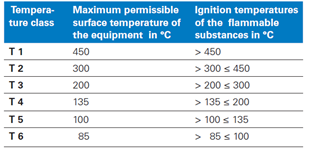
When considering installations that pose a risk of igniting an explosive atmosphere. The equipment used is classified under 3 Groups. Group I refers to equipment used in below ground (i.e. Mining), Group II equipment above ground where gases / vapours may be present. Group III equipment above ground where dusts may be present.
Group II equipment has subgroups based on the amount of energy required to ignite the gas / air mixture. Group III equipment has subgroups based on the type of dust and the potential energy release during combustion. These are shown in Table 2.

Examples of potential non electrical ignition sources
Electromagnet Radiation from Mobile Phones can be a potential source of ignition. IEC 60079-0 specifies max levels of Radio Frequency emissions for the equipment groups, a typical non Ex (Explosive) rated phones RF outputs is 2-4 watts. Table 3 shows potentially incendive RF outputs for the relevant equipment groups

The RF outputs from mobile phones can be potentially incendive for solvent vapours and gases which come under equipment group IIB and IIC.
Group II B typically includes Ethylene, Ethylene oxide, Ethylene glycol, Hydrogen sulphide, Ethyl ether and Town gas (Methane),
Group II C typically includes Hydrogen, Acetylene and Carbon disulphide.
Friction due Bearing Failures
Overheating is generally the result of excessive operating temperatures and improper lubrication.
Higher temperatures also reduce the hardness of the metal, causing early failure.
Example 1
On the evening of September 12, 2017, a ferry’s main engine exploded and burned five running hours after a rebuild. The engineer standing near the engine at the time of the blast, suffered severe burns to his hands and face. An investigation found that a bearing shell had spun on a main bearing blocking the flow of lubricating oil. The conn rod’s big end seized breaking the big end’s bearing bolts. The rod then went through the wall of the crankcase and the lube oil gallery, leading to the explosion. The investigation found high quantities of particulate matter, including unusually large particles of 1mm or greater in the oil filter. This debris may have entered the engine during the three days it was at the site and disassembled prior to installation.
Example 2
Imperial Sugar facility in Georgia, a conveyor belt running between sugar storage silos was enclosed to help prevent the contamination of the sugar on the belt and reduce the amount of dust that needed to be cleaned from the underground tunnels. This caused a cloud of sugar dust built up inside the enclosed conveyor. A blockage caused sugar to spill on to the conveyor bearings one of which overheated and ignited the sugar dust cloud in the enclosed conveyor. The containment caused the explosion to build enough pressure to push it throughout the rest of the building, leading to secondary explosions that caused 14 workers to be killed. The possibility of a dust explosion was not even considered when building enclosing these conveyor belts, even though management at the plant should have been very well aware of the combustibility of sugar dust.

Damage after the catastrophic dust explosion at the Imperial Sugar Co. shown in figure 2
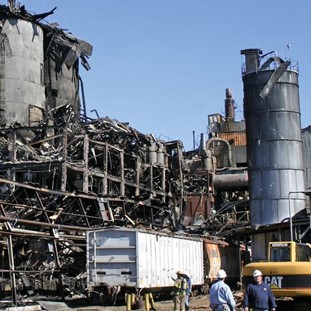
Overview of Dust Ignitions
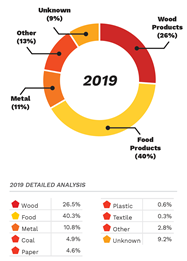
In reviewing the global incident data from Dust Safety Science, food and wood products made up over 65% of the combustible dust fires and explosions recorded. These materials also resulted in 59% of the injuries and 62% of the fatalities. A breakdown of the fires, explosions, injuries and fatalities for each type of material is given as follows:
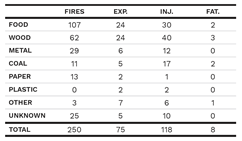
Equipment and Causes
Dust collectors demonstrate the highest percentage of combustible dust incidents with 59 fires and 12 explosions reported in 2019. This is lower than the historic data from the CSB, which suggests up to 40%.
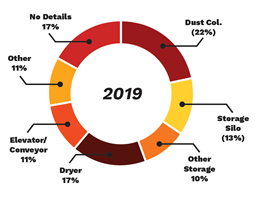
Explosion Prevention & Mitigation
Minimise accumulations of flammables and keep concentration below LEL. Minimise potential sources of ignition and implement suitable monitoring systems for equipment and processes. Maintain spatial separation between accumulations and ignition risks where practical. Design for full confinement in the event of an explosion. Full or partial system inerting. Installation of automatic explosion suppression systems, flame front diverters; explosion venting systems. Passive flap, float and rotary valves.
Examples of explosion prevention & mitigation measures are provided below
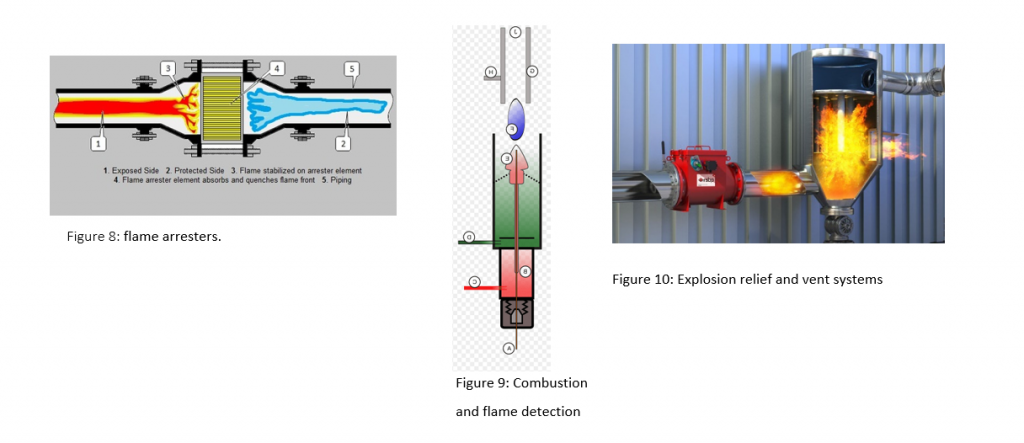
Explosion Isolation via flap, float or rotary valves
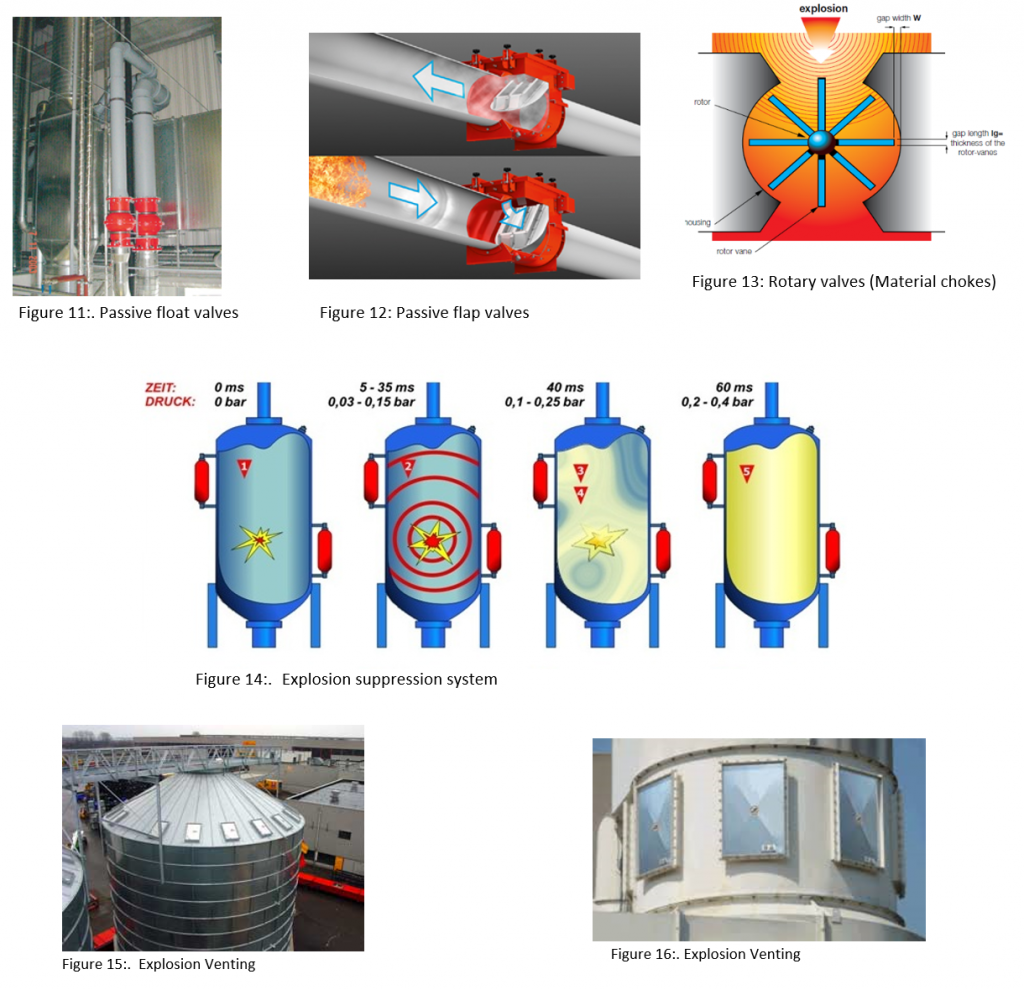
Sign up here to receive the next article in this series directly to your inbox before it goes live to the public
CMSE Consultancy provide professional Occupational, Process, Explosion & Fire Safety Services.
If you require further information or assistance please contact us via email at info@cmse.ie, by phone at 021 497 8100 or start an instant chat with us via the chat box in the bottom right-hand corner of your screen.
